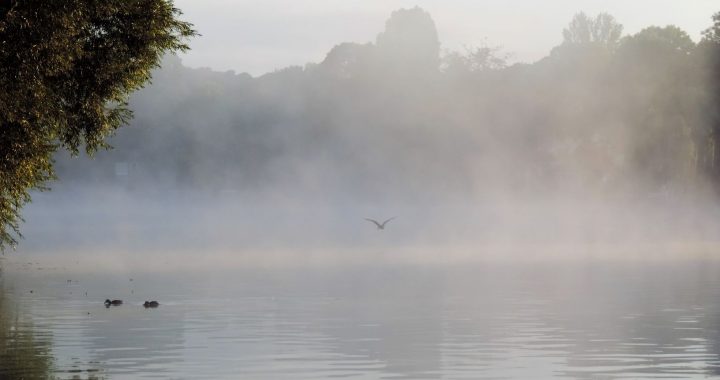Thursday morning brought persistent drizzle so we stayed put until about 11:00, by which time the sky had cleared and the rain stopped, although the air was fresher than it has been for a while. An overnight guest, who had appeared the evening before, had also cleared away by then. We had just settled in for the evening when this chap appeared, laden with all manner of bags and knapsacks, which he dropped down right opposite our boat and about 20 yards from the bank. He proceeded to collect water from the river, where some steps led down to the water’s edge, cook up a meal, wash out his mess tins in the river again, pitch a small dome-shaped pop-up tent and settle down for the night. The tent was still there when we woke in the morning but by the time we were ready to leave he had already struck camp and moved on. We don’t know who he was, we don’t know where he came from or where he was going. We did wonder what we were in for at first but he caused no trouble, interfered with no-one and when he vanished into the morning, he left no sign that he had ever been there. We did speculate, based on the kind of kit he was carrying, the efficiency of his camping activity and the discipline shown in leaving no trace of his presence; that he might be an ex-serviceman but we have no way of knowing now. In retrospect, we wish that we had engaged with him, just a little, to find out more. After all, what was he doing that was so different from ourselves, other than a slight difference in scale?
We set out through Maidenhead on the river and from that vantage point it seemed as unremarkable as we had been led to expect. The river frontage seemed OK but nothing special and we weren’t tempted to change our minds and stop for a tour. Only one lock today, Boulter’s Lock, which we passed through as the sun began to make itself felt again. That took about fifteen minutes so we were tying up at our next mooring after a 2 mile voyage of three quarters of an hour in total. We had chosen to stop at moorings shown on the map as lying alongside the steeply rising hillside of the Cliveden Estate on the Buckinghamshire side. The bank is heavily wooded National Trust land and there are little inlets here and there where posts have been sunk in the bank to tie up to. We found one that we could just fit into but were slightly puzzled as to why, given that this was the only purpose of these posts, they were square rather than round, which would enable mooring lines to slip easily around them. I guess it demonstrates that the NT is a very land based organisation. As evening came near we saw a wide beam approaching, every bit as vast as “Plan B” who had dogged our mooring at both Staines and Bells of Ouzeley. As it came level with us on the opposite side of the river we realised it was a hotel boat. It began to turn through 180° and we realised she planned to moor in a tiny bay 100 yards behind our own. The ensuing half hour of shouting, backing and filling and frequent whining of bow thrusters in action showed that we were right in our belief that they could never fit in the space. Their captain stuck it out, perhaps through sheer refusal to lose face in front of the hotel guests and in the end had her tied up at the stern to a couple of trees, with the bow floating a number of yards out in midstream. With that he declared himself satisfied but we wonder how many of those on board were really fooled that he meant to do that all along.

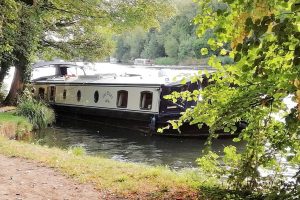
That’ll Do
Cliveden is a very large estate at one time owned by the Astor’s but even more famous as the place where, in the midst of the cold war in 1961, John Profumo met a young model and embarked on the affair that would ruin him and rock the government, as well lead to the phrase “he would say that wouldn’t he?”. The estate has a trail running between the river and a near vertical hillside with paths climbing up to the grounds and gardens high above, as well as the beautiful stately home that is now a private hotel. We had a good wander round the grounds and woodland walks in a now sunny afternoon and looked at various information boards and exhibitions. One of the latter was ‘Cliveden’s Women’, an outdoor exhibition made up of 20 portraits of women with inspiring real-life stories. To be featured, the women needed to have a connection to Cliveden, however loose. Somewhat surprisingly, Christine Keeler was not included, despite her having had a very ‘loose’ connection with Cliveden.
Since having entered the Thames we had got used to the principle of 24 hours free mooring and then having to pay after that. Since leaving Staines, however, despite the general environment having improved from what has, so far, been the low water mark of our trip we seem to have entered the lands of the robber barons. Any Tom, Dick or Harry who has the rights to a couple of yards of river bank, no matter how broken down, overgrown or generally unsuitable it may be, has a right to demand money for mooring against it without any obligations on their part, without being required to maintain any standards with no apparent on limitation or control on the charge they collect and from the moment your mooring lines touch ground. A lot of the moorings are owned by this or that Borough or Parish Council, some are privates estates or just farms with a river frontage. The NT are more than happy to get in on the act. We had to stump up for a night at Runnymede but hadn’t been charged at the Bells of Ouzeley, despite an overstay there. We got away with it in Maidenhead as well. We thought we had escaped at Cliveden too, hidden away in the woodland far below the estate but no, at 09:00 along came the NT warden to collect the fee of £10. At least here it was half price for members of the Trust, so a fiver to us but that too is completely inconsistent with the no concessions approach from the NT at Runnymede.
Friday morning was bright but fresh with a strong, cool breeze as we made our way up to Cookham, about 1½ miles in all. This took us through Cookham Lock, which is interesting in that it has two chambers with a full set of electrically operated gates in the middle, as well as at either end. The lock was built this way to allow smaller boats to be brought through using less water. Apparently these gates were decommissioned last year and will no longer be used. It begs the question as to what has changed in these modern times that the EA don’t see a need to save water any more. I thought it was quite the reverse?
We found a mooring just past Cookham Reach Sailing Club on an overgrown, uneven bank and just deep enough for us to stay afloat. There was no hesitation in the local authority demanding a mooring fee – £4 this time – despite the lack of any effort to make mooring easier.
After lunch we had a good walk around the back of Cookham over Winter Hill, although the viewpoint was obscured by trees and we had clearer vistas on the climb up than at the top. There doesn’t seem to be any such thing as open country around here though. It is a highly populated area and every time you turn a corner there are more people out enjoying the countryside or another lot of houses overlooking the path and every route seems tightly fenced in and controlled. We ended up in Cookham itself and we made our way to the tea shop for a rather mean cream tea. At least the scones were plain but strictly one scone per person that turned out to be served hot having just been microwaved for some reason, perhaps because they were going stale? As it happens we sat inside. Looking out as we poured the tea we realised that, quite contrary to the forecast, it was raining. It was a brief shower, twenty minutes or so but came down very hard and soaked everyone caught in it. It was only by chance that we escaped being among their number so the cream tea did us a favour. Once it stopped we left the shelter of the tearoom and were comfortably back on the boat by the time a much longer and more persistent rainstorm came in about 6 o’clock.

Misty Morning Heron
Happily, the next morning and the start of the Bank Holiday weekend was fine and bright. It was a lot chillier first thing, after the rain and there was a rolling mist across the water. Rearrange these words into a popular phrase or saying: “Is winter coming?”. Our plan was to move up to Marlow early, before people started looking for mooring, get settled in and hole up there until Monday, particularly in view of a consistently horrendous weather forecast for Sunday.

Marlow Approach
We got to Higginson Park in Marlow by about 10:45. While it was very busy we managed to just get in on the mooring there by a water outlet that was supposed to be kept clear. There followed a great game of musical berths. The boat in front said they were just about to leave, the boat that had just arrived said they were happy if we moved into their slot to leave them room behind, then just as we began to haul ourselves into the vacated space another narrowboat, who having just arrived, had not been involved in the discussion began to make a move to moor there. Somehow we managed to sort out the confusion and once the music stopped we had everyone shuffled back and forth until we all had a space. The nice thing is that, on the water, this seems to be generally handled with willing co-operation and good humour. I dread to think what would be the outcome of the same scenario around car parking places in a street in London.
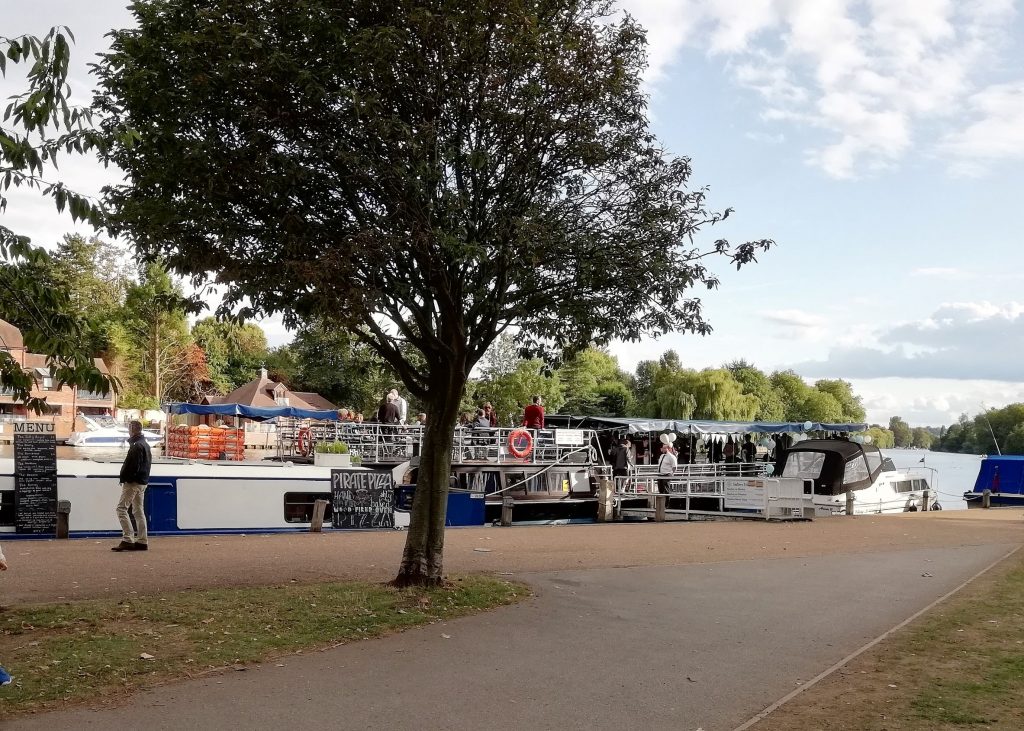
Higginson Park Quayside
The park was teeming. The path beside the river was a constant flow of people and cycles in both directions, the ice cream van was parked just the other side of the asphalt path and when we flung open our own side hatch I had half-expected to be asked for a “99” or a strawberry Mivvi. The bouncy castle and children’s’ roundabout were in operation all day. It wasn’t that hot but stayed mild and pleasant and many families and groups of friends were sat out picnicking into the evening. The mooring fee here was a princely sum of £13 a night! It came with free use of the Leisure Centre showers etc. but that hardly justifies that price. No wonder Marlow is so spotless and well cared for. There was an option to moor for free just a little further down, if there was space. In the end, though we settled for simplicity and peace of mind from knowing that it was sorted until we decided to leave.
While sorting out the mooring I picked up some leaflets from Tourist Information and in the afternoon we managed to combine the Town Walk and the River Walk with the WWI walk into one decent tour of the town and we had become reasonably well acquainted with it by the end.

The Compleat Angler


Across The Bridge
No visit to Marlow could be complete without a visit to The Compleat Angler, now a MacDonalds (not Ronald McDonald; the much more high end MacDonald Hotels & Resorts). This famous inn lies on the south side of the bridge at Marlow and we had a very pleasant pint on the sunlit terrace and perused the bar menu without visibly choking on the prices. It must be said it was an excellent establishment of its kind, spotless, very well-maintained, with excellent service. The reason they showed us the bar menu was because they had no tables available in the restaurant that evening, which says something for the affluence of the area. We drank up quietly and crossed back to the shady side to visit a more modest establishment in the High Street, The George & Dragon. We had a great meal there, at very reasonable cost, in a really nice environment and with service we felt was quite as good as the Angler’s. Definitely to be recommended if you visit the town.
The next day was very different. Everyone we spoke to referenced the heavily trailed downpour, confirming our decision to stay put. I went out early to get ahead of it and have a look at Marlow on the south side of the river. It didn’t take long, Marlow seems to have only a tiny toehold across the water. As you cross the bridge you find The Compleat Angler on one side and the magnificent Marlow Rowing Club on the other, behind which is access to some modern apartments fronting the river that is closed to the public. Beyond that a series of houses, some quite old, some that would have you believe they are older than they are and a few new or extensively remodelled line the road for a quarter mile or so. Beyond that there is nothing until you get to Bisham. It made me wonder why they bothered to include them in Marlow at all. There must be issues in administering a district that straddles the Thames that one could do without.
Arriving back at the boat I noticed the 40 minute short trips on Salters Steamers had also been cancelled “due to heavy rain forecast”. We set out for Sainsbury’s at the top of the town, shopping being a suitable activity for a rainy day if you have to have one. We made it there in the dry but by 10:30 the rain had started in earnest. Taking refuge in Costa didn’t help, it was just an opportunity to watch the rain get progressively harder so we gathered our bags and splashed back to the riverside. For the next five hours we watched the steady downpour while getting on with various indoor tasks that have been steadily backing up during this summer, simply because it has been far too nice outside. The scene in the park could not have been more different from the day before. Completely deserted, no ice-cream van and no rides or bouncy castles at the playground. The advertised table-top sale was postponed to another day and the Pirate Pizza oven on the back of a boat further down remained cold. It began to clear about 16:30 and while a few eager souls emerged, mainly to walk their dogs, they were few and far between.
The next day was a grey start but drier, despite the saturated ground. It brightened up for the morning and a bit more in the afternoon for a mild, fairly sunny, pleasant Bank Holiday Monday. We got going before nine and moved down to stop short of Henley at Temple Island and were moored up before lunch. We had no need to go into a busy place like Henley on a fine Bank Holiday so we planned to have a walk around the area outside today before moving up to the town tomorrow. We followed a route along the river downstream and then over Aston Hill and Remenham Hill to return along the river via the foot of Henley Bridge. It was a nice walk that took us through a private deer park. We saw a lot of different groups and plenty of stags with a full spread of antlers. The white hart used to be viewed as a rare and mystical phenomenon that led to it being adopted on coats of arms that, in turn, gave rise to many pubs called The White Hart. In this park there seemed to be quite a large number that were pale enough to fit the description so perhaps they have become more common.
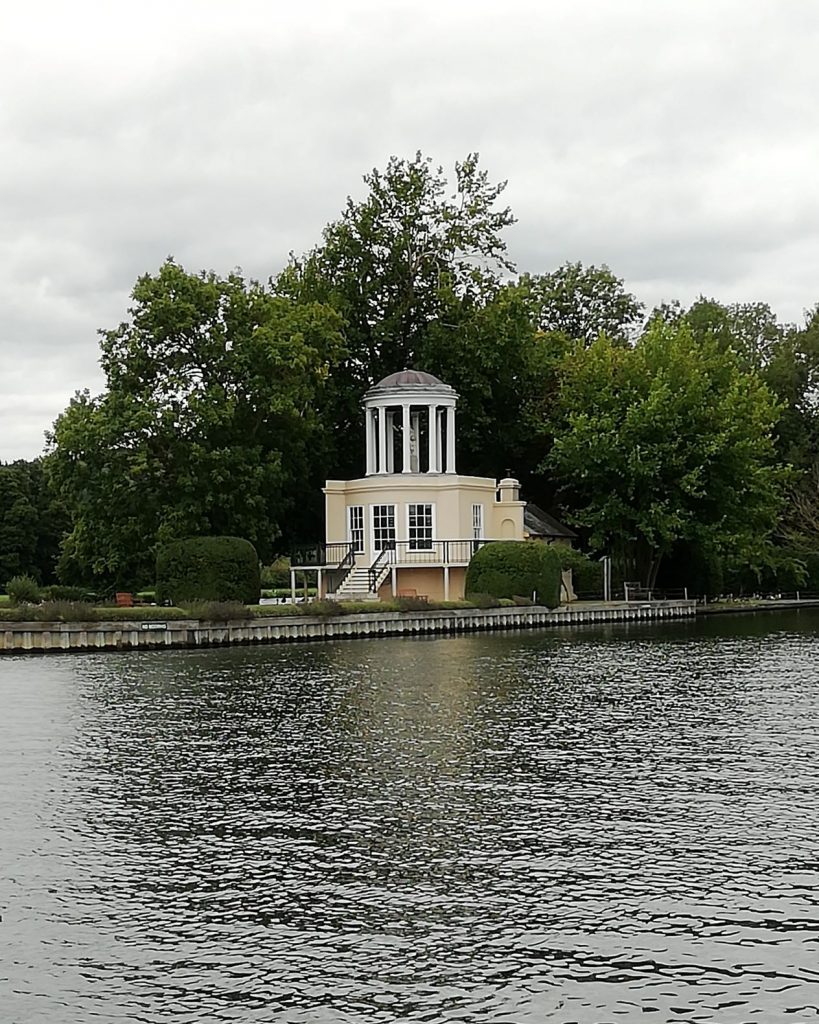
Why it is called Temple Island
We were also accompanied by the constant high-pitched squeal of red kites. We saw a group of 5 or 6 circling just one small spinney and many others on the way. Their whining has followed us up the Thames and they always seem to be around. In the 1930’s these birds were close to extinction and barely survived into the late 1960’s, when the RSPB and various conservation groups began concerted efforts to protect and reintroduce the birds to England and Scotland. I am not sure if they took account of the fact that they had come close to extinction because they were regarded as vermin and were systematically eradicated over centuries. They are now as common as muck and enough of a pest to have signs in Higginson Park in Marlow warning visitors to beware of red kites stealing their food, just like seagulls. I guess conservationists should be wary of what they wish for. One can imagine their next project is likely to be launching a campaign to have the birds’ schedule 1 status repealed in order to allow them to carry out a cull.
We hadn’t really understood how all-consuming the Royal Regatta is in this area. We were actually at the start of the course even where we moored and walked alongside the regatta lawns for most of their length. You could see how many small items to do with the setting up and running of the regatta were permanently installed just to facilitate that one event. There were markers in the ground every few yards, posts in the roads with numbers denoting parking spaces, metal fences and holes for marquee poles that would all be used each year. Even on a Bank Holiday Monday a team of groundsmen were working on the grass, presumably to repair the damage from this year and let it heal by next year.
On Tuesday morning I went out for a recce down into the town and to explore the moorings on the opposite side and beyond the bridge. These town side moorings turned out to be about fifteen minutes’ walk from the bridge, to have limited space and cost the same as those on the regatta side. Now people had left there was plenty of space there that was actually only a couple of minutes’ walk from the bridge across to the town.
There are different people and organisations who own the riparian rights along both banks here but all the signs on either side, right down into the town, announce that a £10 mooring fee, for each 24 hours or part thereof, should be paid, on demand, to SRB Moorings. We presumed this was some faceless corporation who had put in a keen bid to secure the business from the different owners. In fact, it turned out to be just Steve (Steve Ryan-Bell), a cheerful rascal who cruises up and down in his small boat to lift a tenner from anyone he finds or to take a photo and leave a note inviting the owner to send him an instant payment via PayPal if the vessel is unattended, as was the case with us. When we moved up to our new berth he called by in person and we had a brief chat with him. He was full of little titbits like which of the buildings opposite had been the boathouse for George Harrison’s Friar Park estate, which lies above the town. Steve assured us we had made a wise decision to stop here. As well as being closer to town he claimed there had been trouble with the local youths on the moorings beyond the bridge, as they lay beside a public park. This may well have been sound advice, honestly given. However, we did realise that he might just have a vested interest as he has no rights to collect any revenues beyond the bridge, Henley Town Council not yet having embraced outsourcing to that level.
Neil Payne & Karen Payne paid us a brief visit on their way back from Norway for a stopover in the UK before embarking on their European Grand Tour the next day. This planned holiday seems to get extended every time we see them but it sounds like a great trip and we are sure they will have a wonderful time. We can’t help being slightly jealous. We enjoyed catching up for an hour or so before they had to leave and there seemed a lot we didn’t have time to cover, like the location of the VR postbox I had teased Neil with earlier in the week.
Around that visit we explored Henley. It seems a bigger, busier town than Marlow and somehow more self-important. The state of preservation of the buildings seems remarkable. Henley seems to have avoided all the influences that have affected other towns. It doesn’t appear to have ever been bombed or caught fire so wholesale destruction of what went before has not made way for the modern development seen elsewhere. I am guessing the wealth, power and influence surrounding the town during the period over the last couple of centuries when that kind of development was happening elsewhere will also have contributed limiting the degree and type of change. As you get to the outskirts you start to see early 20th century building and some modern office blocks and flats etc. This is most obvious near the station. The coming of the railway was a game change across the nation. Henley couldn’t afford to be left out and it is here that the arrival of the first line and the steady evolution and then decline has taken out chunks of what was there before and then returned it to be built on in the modern style.
Like Marlow, Henley’s presence is principally only on one side of the river with, mainly Regatta HQ, the Leander Club and a few other rowing clubs, including Henley Rowing Club further down. Everything else is on the west side of the river. The sheer scale and opulence of these ‘clubs’ is astonishing in itself. The words ‘rowing club’ suggest a rusty corrugated iron boathouse by the river with, perhaps, a wooden shack beside it to serve as a clubhouse for the members. In reality, they nearly all have magnificent premises, solidly built and several stories high, maintained in immaculate condition. The Leander, in particular, is more like a luxury hotel and there are serried ranks of boats housed in secure buildings that look more like modern, state of the art warehouses. Regatta HQ has its own multi story building across the road from the Leander beside the bridge. It has a dedicated wharf for arriving dignitaries and a beautifully varnished, sleek and powerful motor launch moored there ready to be despatched to fetch them.
The Henley equivalent of The Compleat Angler in Marlow in fame and position is probably The Angel on the Bridge so we had to pay them a visit. Much more of a pub than the luxurious Angler but pleasant enough, although here they are on the shady side of an evening so we were better off inside.
Wednesday was a run down to Sonning with a view to mooring just beyond Sonning Lock as a jumping off point for taking the boat into a marina in Reading. We had an appointment to see our new half-built house in Long Itchington on Friday so we had arranged to take the train from Reading station. We didn’t fancy leaving the boat unattended on the side in central Reading, hence the night booked in the marina. On the way we passed a seemingly endless stream of riverside houses, all huge examples of conspicuous consumption. The wealth in this area really comes home to you when you consider that many of these enormous places are actually just secondary properties to the main residence, essentially the family boathouse.
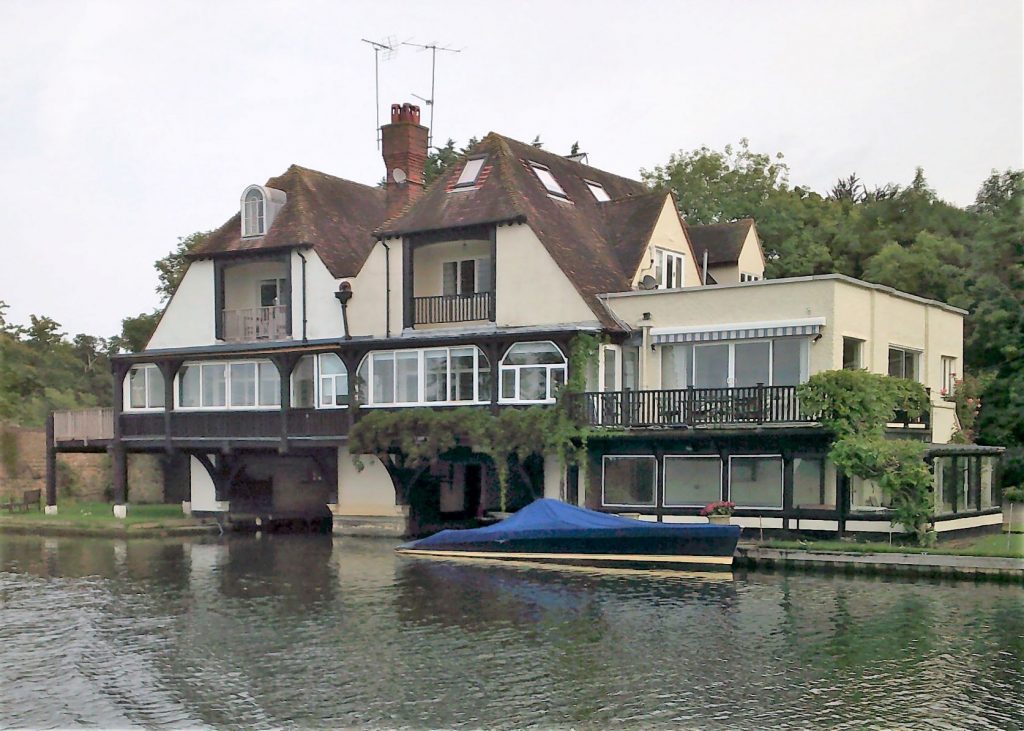
A Relatively Modest Example
For us, Wednesdays cruise was a longish 6½ miles and three locks but we were still moored up for lunch, leaving time for a circular walk from Sonning to Shiplake and back via a place called Binfield Heath. A pleasant walk in the countryside. The first three miles were back along the Thames Path so along the route we had travelled in the morning. Still, the change in perception afforded by the different perspective is always interesting. The Thames Path is always busy but once that was left behind, crossing the fields and woods, it was deserted. This was probably the first time we had the feeling of walking in open country, without bumping into someone round every corner or finding a housing estate every 100 yards, since leaving the Leicester line at the beginning of July. Mainly illusory, of course, with the Thames Valley Business Park in Reading just visible over the treetops on the way down into the valley. Another sign that we might, at last, be leaving the ‘burbs was in the river itself. The waters were no longer clear and transparent, as they had been at Henley and the banks were quite heavily overgrown, forcing us to hack our way through to bang in the pins. Very much more like the canals, in fact. Furthermore, the mooring arrangement had reverted to a free 24 hours so long as you register your arrival. Good news indeed!
At one point, in a small hamlet, there was this sign on a field gate through which could be seen two piebald horses grazing happily.
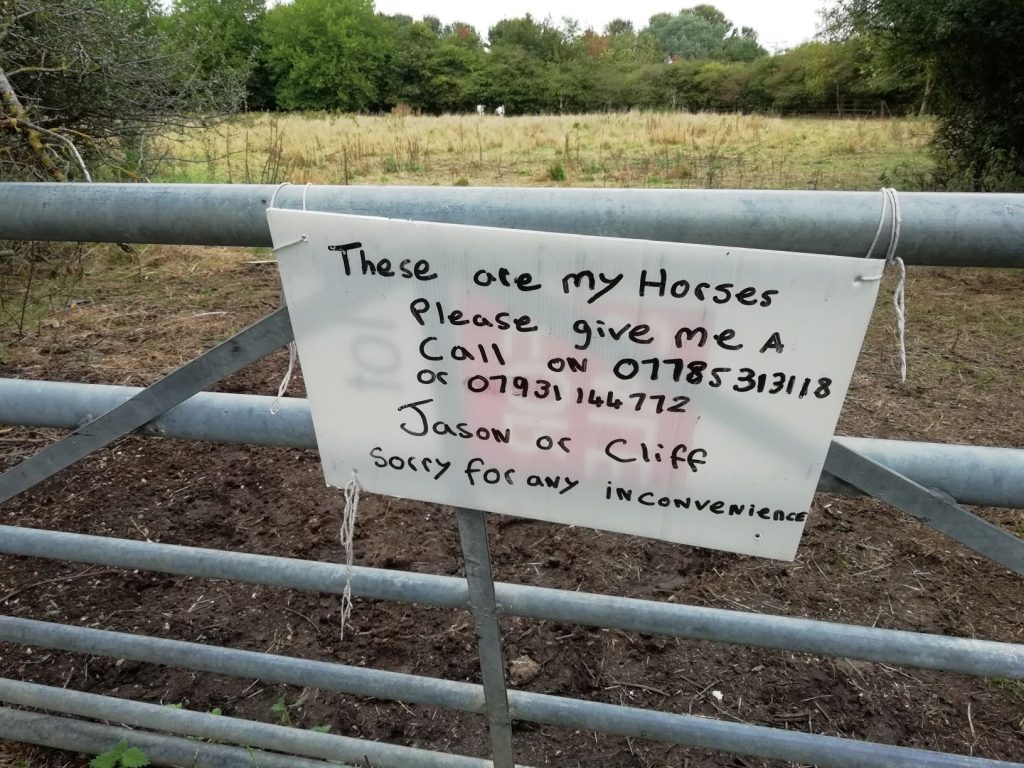
It put us in mind of returning home to our house in Calleydown Crescent many years ago and finding a horse tied to a tree in next door’s front garden. In that case the neighbour had failed to keep up the livery fee and the stable had just returned them to the owners while they were out. Clearly, there has to be a story here too but one can only speculate what it might be about.

